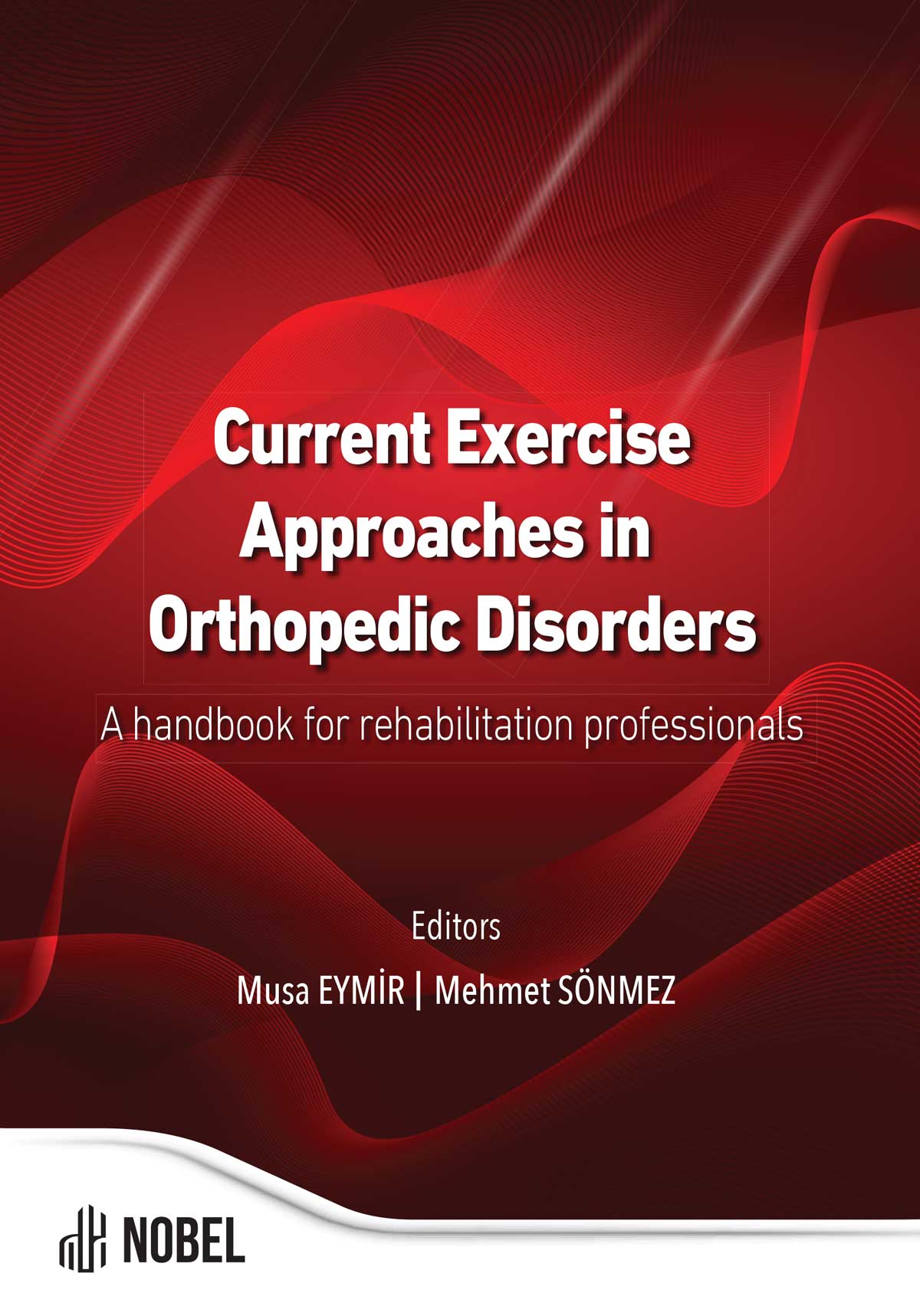Current Exercise Approaches in Shoulder Pathologies
Ayse Yildiz (Author), Mehmet Sonmez (Author)
Release Date: 2024-01-18
The shoulder joint is a very mobile and dynamc joint between the arm and the body.The three-dimensonal movement of the joint allows access to every part of the body. The shoulder joint s a complex consisting of the glenohumoral, acromoclavicular, sternoclavicular and scapulothoracic joints. The shoulder joint functionally allows extension, flexion, abduction, internal and external [...]
Media Type
Buy from
Price may vary by retailers
| Work Type | Book Chapter |
|---|---|
| Published in | Current Exercise Approaches in Orthopedic Disorders A Handbook for Rehabilitation Professionals |
| First Page | 97 |
| Last Page | 124 |
| DOI | https://doi.org/10.69860/nobel.9786053358770.4 |
| Page Count | 28 |
| Copyright Holder | Nobel Tıp Kitabevleri |
| License | https://nobelpub.com/publish-with-us/copyright-and-licensing |
Ayse Yildiz (Author)
PT, PhdD, Asst. Prof. Dr., Erzurum Technical University
https://orcid.org/0000-0002-1101-1069
3She completed her bachelor degree at Kırıkkale University. She completed her Master of Science (2017) and PhD (2022) in the Department of Physical Therapy and Rehabilitation at the Gazi University. Her field of master’s education is "Children with Cerebral Palsy". She worked in Gazi University as a research assistant between 2017 and 2022. Now, she is working at Erzurum Technical University as an Assistant Professor. She has specialized in early intervention in academic activities such as book chapters, academic publications, and congress presentations. She has 10 years of experience in the clinic and she teaches pediatrics at the undergraduate levels. Her primary research focus is on "children with cerebral palsy" “early intervention” “premature infants”.
Mehmet Sonmez (Author)
Asst. Prof. Dr., Erzurum Technical University
https://orcid.org/0000-0002-3617-9087
3The author, aged 34 and married, received his primary, secondary, and high school education in his hometown of Malatya, Turkey. He completed his 4-year undergraduate degree in Physiotherapy and Rehabilitation at Dumlupınar University in 2012. Subsequently, he pursued his master’s degree at Keele University in England, specializing in Neurological Physiotherapy, which he completed in 2018 with a scholarship from the Ministry of National Education of the Republic of Turkey. Upon his return to Turkey, he pursued his doctorate studies in the Physical Therapy and Rehabilitation program at Bolu Abant İzzet Baysal University, graduating in 2023.
Between 2012 and 2015, the author worked as a Physiotherapist at two different Special Education and Rehabilitation centers, located in Malatya and Istanbul, respectively. Additionally, he served as a physiotherapist at a private training and rehabilitation center in Malatya from 2018 to 2019. Transitioning into academia, he became a lecturer in the Department of Physiotherapy and Rehabilitation at Erzurum Technical University, Faculty of Health Sciences, from March 2019 to February 2024. As of February 2024, he has advanced to the position of Assistant Doctor within the same university and department, where he continues his professional endeavors.
Asghar, M., Ahmad, A., Afzal, W., Nawaz, U., Saeed, A., & Rasheed, I. (2023). Effectiveness of Routine Physical Therapy with and Without Core Stability Exercises in Patients with Rotator Cuff Tendinopathy. Dinkum Journal of Medical Innovations, 2(10), 443-451.
Bagcıer, F., & Çüçen Batıbay, S. (2021). The effects of virtual reality exergaming on pain, functionality and acromiohumeral distance in shoulder impingement syndrome patients: A randomized controlled study.
Carnevale, A., Mannocchi, I., Schena, E., Carli, M., Sassi, M. S. H., Marino, M., & Longo, U. G. (2023). Performance Evaluation of an Immersive Virtual Reality Application for Rehabilitation after Arthroscopic Rotator Cuff Repair. Bioengineering, 10(11), 1305.
Chaitow, L., & Crenshaw, K. (2006). Muscle energy techniques. Elsevier Health Sciences.
Chang, L.-R., Anand, P., & Varacallo, M. (2023). Anatomy, shoulder and upper limb, glenohumeral joint. In StatPearls [Internet]. StatPearls Publishing.
Cho, K., Yu, J., & Jung, J. (2012). Effects of virtual reality-based rehabilitation on upper extremity function and visual perception in stroke patients: a randomized control trial. Journal of physical therapy science, 24(11), 1205-1208.
Çelik, D. (2022). Olgularla Ortopedik Rehabilitasyon (Ç. Derya, Ed.). Istanbul Tıp Kitabevleri.
Dejaco, B., Wagener, M., & Lewis, J. (2023). “ I Was Focused on the Game and Not on My Shoulder.” A Case Report on the Use of Virtual Reality in the Rehabilitation of an Unstable Shoulder. JOSPT Cases, 3(3).
Demirhan, M., & Göksan, M. (1993). Omuz eklemi biomekanigi ve kas kontrolü. Acta Orthop Traumatol Turc, 27(3), 212-217.
Dominguez-Romero, J. G., Jiménez-Rejano, J. J., Ridao-Fernández, C., & Chamorro-Moriana, G. (2021). Exercise-based muscle development programmes and their effectiveness in the functional recovery of rotator cuff tendinopathy: a systematic review. Diagnostics, 11(3), 529.
Ellenbecker, T. S., & Davies, G. J. (2001). Closed kinetic chain exercise: a comprehensive guide to multiple joint exercise. Human Kinetics.
Esculier, J.-F., Vaudrin, J., Beriault, P., Gagnon, K., & Tremblay, L. E. (2012). Home-based balance training programme using Wii Fit with balance board for Parkinsons? s disease: A pilot study. Journal of Rehabilitation Medicine, 44(2), 144-150.
Ewald, A. (2011). Adhesive capsulitis: a review. American family physician, 83(4), 417-422.
Felstead, A. J., & Ricketts, D. (2017). Biomechanics of the shoulder and elbow. Orthopaedics and Trauma, 31(5), 300-305.
Hanratty, C. E., McVeigh, J. G., Kerr, D. P., Basford, J. R., Finch, M. B., Pendleton, A., & Sim, J. (2012). The effectiveness of physiotherapy exercises in subacromial impingement syndrome: a systematic review and meta-analysis. Seminars in arthritis and rheumatism,
| onix_3.0::thoth | Thoth ONIX 3.0 |
|---|---|
| onix_3.0::project_muse | Project MUSE ONIX 3.0 |
| onix_3.0::oapen | OAPEN ONIX 3.0 |
| onix_3.0::jstor | JSTOR ONIX 3.0 |
| onix_3.0::google_books | Google Books ONIX 3.0 |
| onix_3.0::overdrive | OverDrive ONIX 3.0 |
| onix_2.1::ebsco_host | EBSCO Host ONIX 2.1 |
| csv::thoth | Thoth CSV |
| json::thoth | Thoth JSON |
| kbart::oclc | OCLC KBART |
| bibtex::thoth | Thoth BibTeX |
| doideposit::crossref | CrossRef DOI deposit |
| onix_2.1::proquest_ebrary | ProQuest Ebrary ONIX 2.1 |
| marc21record::thoth | Thoth MARC 21 Record |
| marc21markup::thoth | Thoth MARC 21 Markup |
| marc21xml::thoth | Thoth MARC 21 XML |

